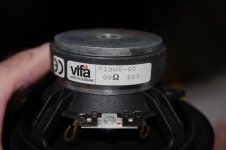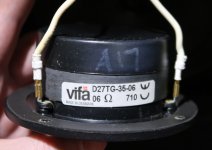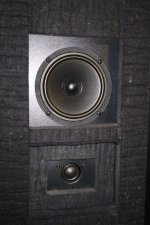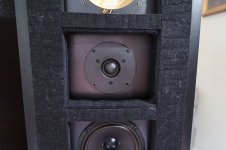D27TG35 or are these early production? Per Andrew Rigby (Dunlavy support) mid-90's, the change happened around serial # 250. I'm not sure which tweeter was used for the 1st year or so of production. Per Stereophile's SC-IV review, it was a Vifa fabric dome but not silk.I was originally led to believe by the (new) owner that the tweeter had been changed.
Now I have them here, I can say they have not been changed.
These speakers are factory original.
Measurements of the XO's outputs would be interesting - and appreciated! - if you're equipped to make them.I have zero plans on changing any component values.
Just updating the solen (shudders) parts for more modern, better manufactured items.
I believe this is how DAL matched each speaker to the production target. The process was driven by the acoustic results, not matching the prototype's parts. The earlier post about tweaking every speaker in an anechoic chamber applies.It's seems, that there was several revisions of the crossovers. I took the SC-IV crossovers photo when a colleague asked to replace damaged tweeters. Although revision printed in the PCB looks the same, however the crossovers physically looks slightly different (mine have more capacitors and coils).
I find DAL's "100% quality control" process quite interesting, and it required such complicated production & testing. Especially with early-90s' technology.
The crossover should be upgraded. Remove all wire-wound resistors and replace with thin film (transistor package) mounted on heat sink. It is a must for tweeter, than for the mids. But You can leave on bass units. Second, replace this small inductor with same value but larger dia wire. Every reactive component should be free from other inside. Otherwise different calculations formulas is valid.
.
Note that thin film Rs are 5W rated without the heatsink. WITH HS rate is 25W.
.
Even this bigger L with 0.8ohms are little insufficient for bass range. Should be 1/2 or 1/3 of that value in DC res.
.
Only after these mods You can try some different brand C of the same value, if You want to experiment. But do not go under in quality and price. I think that present C are good?
Most of the diyers first exchange Cs, this is the easy way, chip way, and opposite steps...
cheers
.
Note that thin film Rs are 5W rated without the heatsink. WITH HS rate is 25W.
.
Even this bigger L with 0.8ohms are little insufficient for bass range. Should be 1/2 or 1/3 of that value in DC res.
.
Only after these mods You can try some different brand C of the same value, if You want to experiment. But do not go under in quality and price. I think that present C are good?
Most of the diyers first exchange Cs, this is the easy way, chip way, and opposite steps...
cheers
Last edited:
It's seems, that there was several revisions of the crossovers. I took the SC-IV crossovers photo when a colleague asked to replace damaged tweeters. Although revision printed in the PCB looks the same, however the crossovers physically looks slightly different (mine have more capacitors and coils).
Awesome many thanks for the pics. I always find it interesting to see revisions or changes in the same device. I have seen mention of changes mainly to the tweeter section that others think are to help protect the tweeter more. There are many posts around talking of destroyed tweeters.
D27TG35 or are these early production? Per Andrew Rigby (Dunlavy support) mid-90's, the change happened around serial # 250. I'm not sure which tweeter was used for the 1st year or so of production. Per Stereophile's SC-IV review, it was a Vifa fabric dome but not silk.
Measurements of the XO's outputs would be interesting - and appreciated! - if you're equipped to make them.
I haven't removed any drivers to confirm model numbers (yet
These are serial '10xx - A'. The date code on the caps are predominantly 1996 with one coded 1995. If I assume (dangerous I know) the caps were bought in low volume batches to suit the time of production, I'm guessing the speakers would have been built somewhere 1996 onwards.
Measurement of the crossover output, I'm not sure how I'd do that.
I believe most often over think the potential alteration of 'sound' from crossover changes as I believe the room has far more effect than any other variable.
For example. My friends room is massive so it should suit these speakers nicely. Something like 10 meters wide x 9 meters deep. Ceiling hight around 3 mtrs. Speakers were 6 mtrs apart and best listening position is at the back wall.
My room is an 'L' shaped lounge with the main area a paltry 4 mtr wide by 6 mtr deep with 2.4 mtr ceilings, so on the edge of being too small according to Mr Dunlavy. Worse still the speakers are barely 2 mtrs apart with the listener about 2.5 mtrs from the speakers.
Yet, in friends room they sound absolutely disgusting. lack of bass, very recessed mids, almost ear shredding treble.
And in my room, everything changes. There is bass there, it does go deep, but it feels restricted. Probably as I'm used to ported speakers. And the main speakers in there are 15" JBL's.
Midrange is far better but still a tiny bit recessed, treble is the biggest improvement, still a touch grainy but better although (to me) the tweeters still need a fly poop more attenuation.
Dagnabit, now I want to remove and investigate the drivers properly
Oh and honestly I'm enjoying the conversation about step response etc, so please, continue.
Hmmm.
Unless you really. Really. Know what you are doing, and have a pretty solid measurement system then I feel happy to go out on a limb and say that anything you do th these speakers will result in them being less accurate than they started.
I worked across the road from dunlavy in the early 90s, and had some interaction with him and with the spin offs that came out of his company.
They knew the science and process in a way few do.
Yes, as in all high end audio there were lashings of hype. But if you think "technology has moved" you are being rather optimistic.
As an ardent advocate of DSP crossovers, I agree that active would indeed be a "good thing". But here is the rub...
The whole essence and ethos of dunlavey was "perfect impulse response".
This came out in a couple of conversations I has with him. His passion was that a speaker with a perfect impulse response would by necessity have a great amplitude and phase response.
This leads to (not exclusively but certainly practivally) a first order crossover.
If this doesn't make sense, leave those speakers well alone and go screw with some generic speakers.
They started life as high end speakers hand tuned by experts.
I love DIY and love building stuff - but on these would do a check out and polish up.
Unless you really. Really. Know what you are doing, and have a pretty solid measurement system then I feel happy to go out on a limb and say that anything you do th these speakers will result in them being less accurate than they started.
I worked across the road from dunlavy in the early 90s, and had some interaction with him and with the spin offs that came out of his company.
They knew the science and process in a way few do.
Yes, as in all high end audio there were lashings of hype. But if you think "technology has moved" you are being rather optimistic.
As an ardent advocate of DSP crossovers, I agree that active would indeed be a "good thing". But here is the rub...
The whole essence and ethos of dunlavey was "perfect impulse response".
This came out in a couple of conversations I has with him. His passion was that a speaker with a perfect impulse response would by necessity have a great amplitude and phase response.
This leads to (not exclusively but certainly practivally) a first order crossover.
If this doesn't make sense, leave those speakers well alone and go screw with some generic speakers.
They started life as high end speakers hand tuned by experts.
I love DIY and love building stuff - but on these would do a check out and polish up.
leave those speakers well alone and go screw with some generic speakers.
They started life as high end speakers hand tuned by experts. I love DIY
and love building stuff - but on these would do a check out and polish up.
Wise words.
Wise words.
I've changed out parts on Duntechs XO's with very good results. Do so 'without fear' but measure the values of the components before you do, and be sure to use the exact same values, they were built in matched pairs (speakers), and absolute values will be important, and not necessarily the same WRT each XO.
Last edited:
Hmmm.
Unless you really. Really. Know what you are doing, and have a pretty solid measurement system then I feel happy to go out on a limb and say that anything you do th these speakers will result in them being less accurate than they started.
I worked across the road from dunlavy in the early 90s, and had some interaction with him and with the spin offs that came out of his company.
They knew the science and process in a way few do.
Yes, as in all high end audio there were lashings of hype. But if you think "technology has moved" you are being rather optimistic.
As an ardent advocate of DSP crossovers, I agree that active would indeed be a "good thing". But here is the rub...
The whole essence and ethos of dunlavey was "perfect impulse response".
This came out in a couple of conversations I has with him. His passion was that a speaker with a perfect impulse response would by necessity have a great amplitude and phase response.
This leads to (not exclusively but certainly practivally) a first order crossover.
If this doesn't make sense, leave those speakers well alone and go screw with some generic speakers.
They started life as high end speakers hand tuned by experts.
I love DIY and love building stuff - but on these would do a check out and polish up.
Enjoyed your post, thanks.
Yes, if it isn't intuitively obvious that a perfect impulse equals flat amplitude and flat phase,
and also obvious that a first order crossover is the closest thing you can get to flat phase in the world of IIR...
well, time to leave the speakers be.
But, if those points are clear, and one has the measurement skills as mentioned needed, then I'd hazard a guess the Dunlavey's are probably some of the easiest speakers to tinker with that there are.
Because you have to reason that first order crossovers can only be used on designs that have broad, well behaved, acoustic overlap between drivers. Most of the work has already been done....it should be easy to tie together, especially active.
I remember John D's posts from way back, usenet if I remember correctly....
What a down to earth, nice, smart guy. I remember him saying Sony MDR 7506 headphones were his reference for tuning his speakers. I thought, what a real world dude...doesn't care about impressing people with expensive gear comparisons.
He was also one of the ones who started me thinking about linear-phase.
IMO, that's all he was really advocating, with first order being as close to linear as then was possible. (and easily implemented without additional all-pass networks).
I belive those scr poly caps are of high quality that also are immune to ageing, so i can not see why these should be replaced? The drivers however may have changed over time.
I think this and googlyone's suggestions are right on the money.
It would be the equivalent of modifying a Pass Labs amp just because you can.
Don't think you'll achieve anything just by fiddling with the crossover, more likely will make it worse.
I did not know John Dunlavy personally, but I was inspired by his ideas ever since I arrived in Adelaide nearly 30 years ago.
His company then, Duntech was a world leader in speaker design although many other people in the industry were hesitant to acknowledge it.
Despite the fact that quite a few of them built their carriers because of the work of John Dunlavy.
The sad fact was he left South Australia and went back to his native US, and Australia as a whole lost a giant in speaker design.
Still his ideas are very much alive.
If you ask me, an owner can do with his speakers whatever he feels is right. You can even improve a product, sometimes, if you are really good, but when it comes to changing owners, then all your mods aren't worth a dime. Keep the original filter board and parts as they came from factory, the wires too.
The only issue the Dunlavys had were the relatively soft diaphragm materials he used back in the day and this set a imit on how far you can push a driver
They did sound fantastic as I remember them.
Today, take a listen to the Vandersteen 7 with the balsa/carbon fiber materials for how far time alignment has come with rigid diaphrams.
6db networks need well behaved response outside their bandpass requirements
His CF/BW dome has a first breakup mode of 60khz for example.
Unless you have the means to adjust and measure and physically move drivers in and out, any change you make will move away from its intended purpose.
Personally I would leave well enough alone and preserve a classic design.
Regards
David
They did sound fantastic as I remember them.
Today, take a listen to the Vandersteen 7 with the balsa/carbon fiber materials for how far time alignment has come with rigid diaphrams.
6db networks need well behaved response outside their bandpass requirements
His CF/BW dome has a first breakup mode of 60khz for example.
Unless you have the means to adjust and measure and physically move drivers in and out, any change you make will move away from its intended purpose.
Personally I would leave well enough alone and preserve a classic design.
Regards
David
I've replaced SC-IV tweeters, thankfully when DAL was still around to provide a set matched to the speaker's original pair. The job's easy enough.I haven't removed any drivers to confirm model numbers (yet) as I don't want to risk marring the cabinets, felt or gaskets etc. If I do go that far I shall report what I find.
I don't recall the gasketing, but I'm sure there were no issues with sticking, residue, etc. Of course, that may be a little different after 20 more years...
Drivers are not soldered, and the D27s do fit thru the hole in the felt. Just take your time & get the angle right.
Not that I'm suggesting you should do this just for grins!
No worries. It just strikes me that documenting & duplicating the factory transfer functions would be the best first step to activating these speakers, particularly when each speaker's is unique.Measurement of the crossover output, I'm not sure how I'd do that.
This is not directed at any one in particular.
It is a general thought thrown out for all and sundry.
But it will be interesting to see who comes up with what answers.
Being an individual, I have my own thoughts and opinions, which I will keep to myself.
So I have a question.
Sort of a question.
A technical question.
Not a question about sound or perceived sound.
A question relating to physical measurements. (Step response, Distortion, Time delay, Power response, etc)
Maybe it's not a question at all.
You decide.....
Pick a crossover, Any crossover you like.
Replace a 10ohm 10w resistor for a 10ohm 10w resistor of a different brand.
What will that change in the system ?
What about if it's a carbon film, a metal film, a wire wound, a carbon rod ?
(Ignoring the possible effects of the micro inductance in most wire wounds for the moment)
Aw hell, what the heck, have it, throw in your thoughts on the effect of changing a resistors < 1.0 uH.
Same question but with a capacitor.
Replace a 100uF PP capacitor with a 100uF pp capacitor of a different brand.
Again, what will that change in the system ?
And just to really annoy the snot out of everyone.
Why stop there.
Lets swap out the inductor.
A 5mH with another 5mh inductor that has the exact same dcr. But again, a different brand.
Oh ya marks, get set, GO !!

It is a general thought thrown out for all and sundry.
But it will be interesting to see who comes up with what answers.
Being an individual, I have my own thoughts and opinions, which I will keep to myself.
So I have a question.
Sort of a question.
A technical question.
Not a question about sound or perceived sound.
A question relating to physical measurements. (Step response, Distortion, Time delay, Power response, etc)
Maybe it's not a question at all.
You decide.....
Pick a crossover, Any crossover you like.
Replace a 10ohm 10w resistor for a 10ohm 10w resistor of a different brand.
What will that change in the system ?
What about if it's a carbon film, a metal film, a wire wound, a carbon rod ?
(Ignoring the possible effects of the micro inductance in most wire wounds for the moment)
Aw hell, what the heck, have it, throw in your thoughts on the effect of changing a resistors < 1.0 uH.
Same question but with a capacitor.
Replace a 100uF PP capacitor with a 100uF pp capacitor of a different brand.
Again, what will that change in the system ?
And just to really annoy the snot out of everyone.
Why stop there.
Lets swap out the inductor.
A 5mH with another 5mh inductor that has the exact same dcr. But again, a different brand.
Oh ya marks, get set, GO !!
Ok, here we go:
We all know that this is subjective.
People will claim to hear differences when told of a change of component, although that change may have not happened.
From you list the only one that may present any miniscule difference is the capacitor.
May is the key word.
Changing from one type of capacitor to another type is a completely different story.
If one is talking low level signal, re. Phono pre, then resistor types might make some difference but not by much.
And who can say if the difference is for better or worse?
Now let the flame war begin.
We all know that this is subjective.
People will claim to hear differences when told of a change of component, although that change may have not happened.
From you list the only one that may present any miniscule difference is the capacitor.
May is the key word.
Changing from one type of capacitor to another type is a completely different story.
If one is talking low level signal, re. Phono pre, then resistor types might make some difference but not by much.
And who can say if the difference is for better or worse?
Now let the flame war begin.
- Home
- Loudspeakers
- Multi-Way
- Dunlavy SC IV schematics ?



